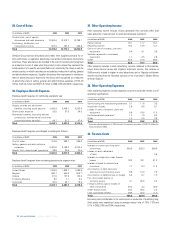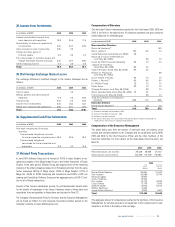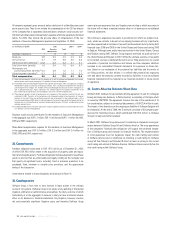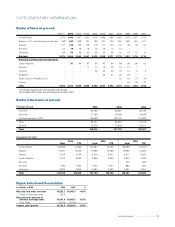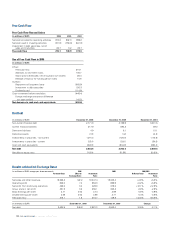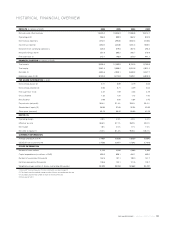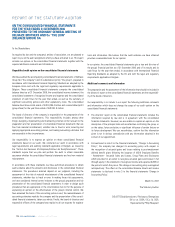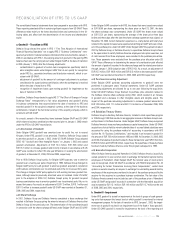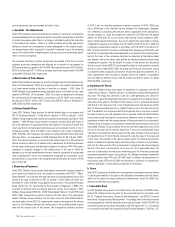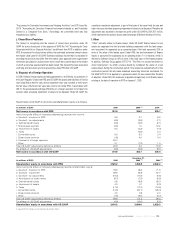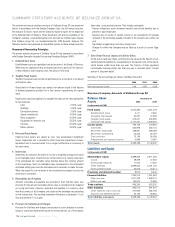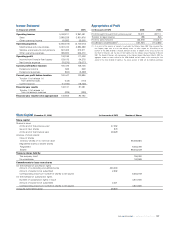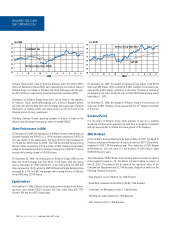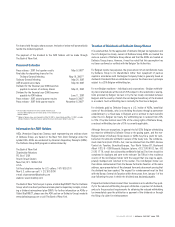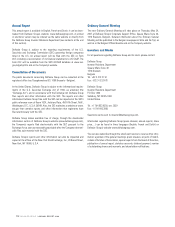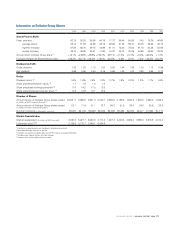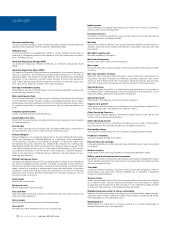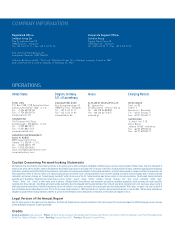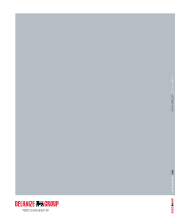Food Lion 2006 Annual Report Download - page 106
Download and view the complete annual report
Please find page 106 of the 2006 Food Lion annual report below. You can navigate through the pages in the report by either clicking on the pages listed below, or by using the keyword search tool below to find specific information within the annual report.and no impairment loss was recorded for Kash n’ Karry.
c. Goodwill - Tax Adjustments
Under IFRS, purchase accounting adjustments relating to income tax contingencies
recorded subsequent to the original acquisition accounting are recorded as an offset
to income tax expense when there is a change in estimate regarding the realization
of the deferred tax balance. Under U.S. GAAP, purchase accounting adjustments
relating to income tax contingencies recorded subsequent to the original acquisi-
tion accounting are offset to goodwill. If goodwill is reduced to zero, the remaining
amount first reduces other intangible assets, and any excess is recorded as an adjust-
ment to income tax expense.
The favorable resolution of certain tax accruals that existed at the time of certain
purchase accounting transactions are reflected as a reduction to tax expense for
IFRS and a reduction to goodwill for US GAAP. The adjustments were EUR 4.9 million,
EUR 3.9 million and EUR 7.1 million to increase income tax expense under US GAAP
during 2006, 2005 and 2004, respectively.
d. Amortization of Trade Names
Under IFRS, Delhaize Group does not amortize intangible assets with indefinite lives.
Upon first-time adoption of IFRS, this accounting policy was applied retrospectively
to all trade names existing at the date of transition, on January 1, 2003. Under US
GAAP, Delhaize Group ceased amortizing intangible assets with indefinite lives, upon
adoption of SFAS No. 142 on January 1, 2002. As a result, an adjustment to decrease
the carrying amount of trade names in accordance with US GAAP was recorded in
the amount of EUR 6.7 million, EUR 7.5 million and EUR 6.5 million at December 31,
2006, 2005 and 2004, respectively.
e. Defined Benefit Plans
Under IFRS, Delhaize Group accounts for defined benefit plans in accordance with
IAS 19 “Employee Benefits”. At the date of transition to IFRS on January 1, 2003,
Delhaize Group recognized all existing unrecognized actuarial gains and losses. After
January 1, 2003 Delhaize Group elected to recognize actuarial gains and losses in
full in the statement of recognized income and expense in the period in which they
occur (see Note 3). Actuarial gains and losses are not recognized in profit or loss in
subsequent periods. Under US GAAP, a new statement was issued in September
2006: SFAS No. 158 “Employers’ Accounting for Defined Benefit Pension and Other
Retirment Plans – an amendment of FASB Statements No. 87, 88, 106 and 132(R).”
SFAS 158 requires employers to recognized the funded status of a defined benefit
plan as an asset or liability in its balance sheet, measured as the difference between
the fair value of plan assets and the benefit obligation. In addition, SFAS 158 requires
employers to recognize changes in that funded status in the year in which the
changes occur through comprehensive income. Amounts recognized in accumulated
other comprehensive income are subsequently recognized as components of net
periodic benefit cost pursuant to the recognition and amortization provisions of SFAS
Nos. 87 and 106.
f. Share-based Payments
Under IFRS, Delhaize Group records share-based compensation expense related to
stock options and restricted stock unit awards in accordance with IFRS 2 “Share-
Based Payment” for all options and restricted stock unit awards granted but not fully
vested at the date of transition to IFRS on January 1, 2003. Under US GAAP, until
December 31, 2004, Delhaize Group applied the provisions of Accounting Principles
Board Opinion No. 25, “Accounting for Stock Issued to Employees” (“APBO 25”),
for grants of restricted stock unit awards and stock options. As of January 1, 2005,
Delhaize Group adopted SFAS No. 123(R) “Share-Based Payment.” Under IFRS 2 and
SFAS 123(R), compensation expense is based on the fair value of the share-based
awards. Delhaize Group estimates the fair value using the Black-Scholes-Merton
valuation model. Under APBO 25, compensation expense was based on the intrinsic
value (i.e., the difference between the market price of the underlying share at grant
date and the exercise price of the award). The retrospective transition provision
of IFRS 2 and the modified prospective transition provision of SFAS 123(R) give
rise to differences in the historical income statement for share-based compensa-
tion. Differences surrounding the effective date of application of the standards to
unvested shares (i.e., using the straight-line method for US GAAP and the graded
method for IFRS) give rise to both current and historical income statement differ-
ences in share-based compensation. As a result, adjustments were made to increase
compensation expense in accordance with US GAAP by EUR 2.8 million in 2006 and
to decrease compensation expense in accordance with US GAAP, in the amount of
EUR 1.0 million and EUR 19.2 million in 2005 and 2004, respectively. Under IFRS, a tax
benefit for tax deductible share-based payments is recognized in the operating state-
ment at the lower of the cumulative realizable tax deduction at the balance sheet
date based on the current share value and the tax effected cumulative share-based
compensation expense. Any tax benefit in excess of that amount are recognized
directly in equity. Under APBO 25, all tax benefits related to stock options is recorded
directly in equity. Under SFAS 123(R), the equity pool from past stock option activity
is considered when recognizing tax benefits through the operating statement. As a
result, adjustments were recorded to increase income tax expense in accordance
with US GAAP by EUR 3.9 million, EUR 3.5 million and EUR 6.5 million, for 2006,
2005 and 2004, respectively.
g. Impairment of Assets
Under IFRS, Delhaize Group tests assets for impairment in compliance with IAS 36
“Impairment of Assets”, whenever events or circumstances indicate that impairment
may exist. The Group has identified a store as a cash generating unit. Stores for
which there is potential impairment are tested for impairment by comparing the car-
rying value of the assets to the higher of their value in use (i.e., projected discounted
cash flows) or fair value less costs to sell. If impairment exists, the assets are written
down to their recoverable amount (i.e., higher of value in use or fair value less cost to
sell). If impairment is no longer justified in future periods due to a recovery in assets’
fair value or value in use, the impairment loss is reversed. Under US GAAP, Delhaize
Group reviews long-lived assets for impairment whenever events or changes in cir-
cumstances indicate that the carrying amount of the assets may not be recoverable.
If these events or changes in circumstances indicate that such amounts could not be
recoverable, Delhaize Group estimates the future cash flows expected to result from
the use of the asset and its eventual disposition. If the sum of undiscounted future
cash flows is less than the carrying amount of the asset, Delhaize Group recognizes
an impairment loss for the difference between the carrying value of the asset and
its fair value. The estimate of fair value considers prices for similar assets and the
results of analyses of expected future cash flows using a discount rate commensu-
rate with the risks involved. After an impairment is recognized, the reduced carrying
amount of the asset is accounted for as its new cost. For a depreciable asset, the
new cost is depreciated over the asset’s remaining useful life. Reversal of previously
recognized impairment losses is not permitted. The differences between impairment
losses recognized under IFRS and US GAAP result in different carying amounts of
fixed assets under IFRS and US GAAP, and therefore in differences in depreciation
expenses and gains or losses arising on diposals of fixed assets.
h. Taxes
Under IFRS, deferred tax liabilities are not recognized on tax-exempt reserves relating
to capital gains realized in the past on the disposal of investments and real estate,
which will be taxed only when distributed to shareholders. Under US GAAP, such
deferred tax liabilities are recognized.
i. Convertible Bond
In 2004, Delhaize Group issued a convertible bond in the amount of EUR 300 million.
Under IFRS, Delhaize Group accounts for the convertible bond in accordance with
IAS 32 “Financial Instruments: Disclosure and Presentation”, and IAS 39 “Financial
Instruments: Recognition and Measurement”. Accordingly, the convertible bond was
recognized partly as a liability and partly as an equity instrument. Under US GAAP, the
convertible bond was recorded in accordance with APB Opinion No. 14, “Accounting
for Convertible Debt and Debt issued with Stock Purchase Warrants”, SFAS No. 133,
/ ANNUAL REPORT 2006
104


